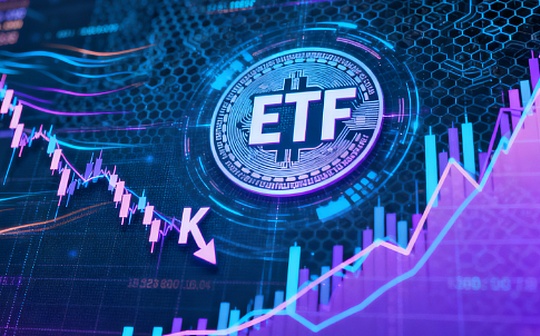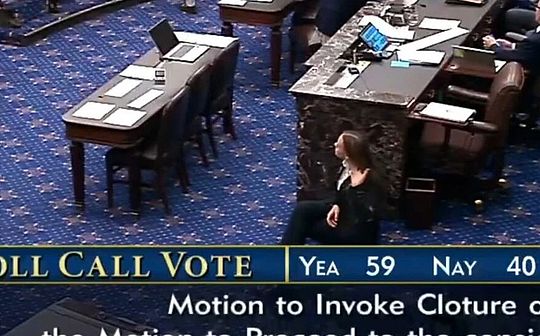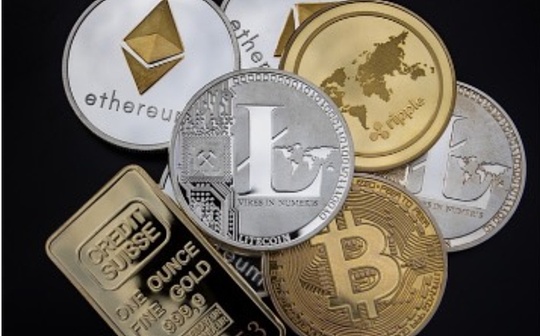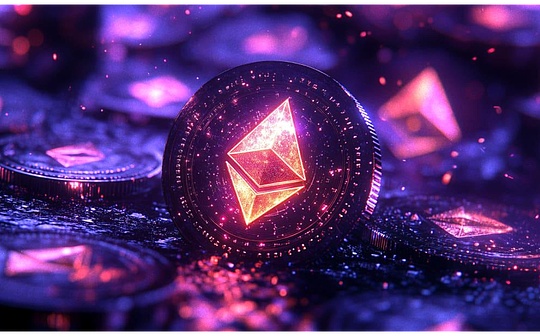
On June 20, at the 214th Ethereum Execution Layer Core Developers Conference (ACDE), the core developers agreed to keep the final scope of Fusaka upgrades basically unchanged, adding only one additional EIP (EIP 7939), that is, covering 12 EIPs, which also marks Fusaka’s official move from “planning” to “substantive implementation” stage.
As the largest hard fork bundling upgrade since The Merge, the market generally expects that if Fusaka can be launched as planned by the end of 2025, it will bring another round of order of magnitude improvement to the L2 data space. L2’s transaction fees may be further reduced in the next 1-2 years, thereby consolidating Ethereum’s position in front of its competitors.
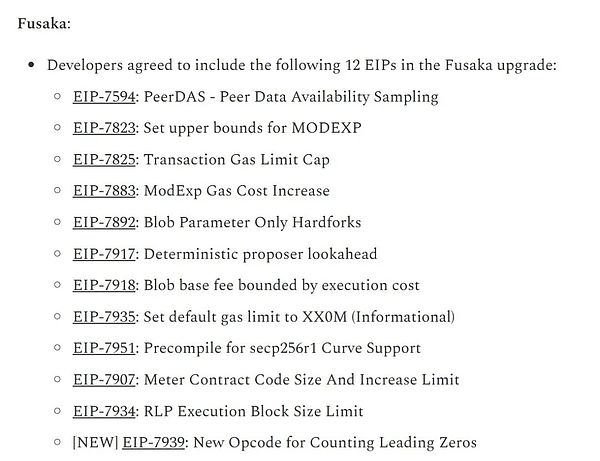
Continuous expansion logic of Ethereum roadmap
As we all know, the scalability problem of Ethereum was once the core bottleneck for the high cost of main network links and the difficulty of popularizing DApps.
According to data publicly shared by Vitalik in April this year, the current throughput of Ethereum L1 is 15 transactions per second, and the Gas cap has recently increased to 36 million, an increase of about 6 times in the past 10 years.
At the same time, more significant changes occurred in Ethereum L2. The current L2 throughput reaches about 250 TPS, which has made significant progress in scalability. This capability not only remains on book data, but many users have also clearly felt the speed of on-chain operations:
The past year,Whether it is Arbitrum, Optimism or Base, L2 transfer fees generally fell to the range of 0.01 USD or even lower, down from the previous decline of one or even multiple orders of magnitude.The daily Gas cost of the Ethereum main network is also significantly more friendly (of course, the impact of market conditions and on-chain activity is not ruled out).
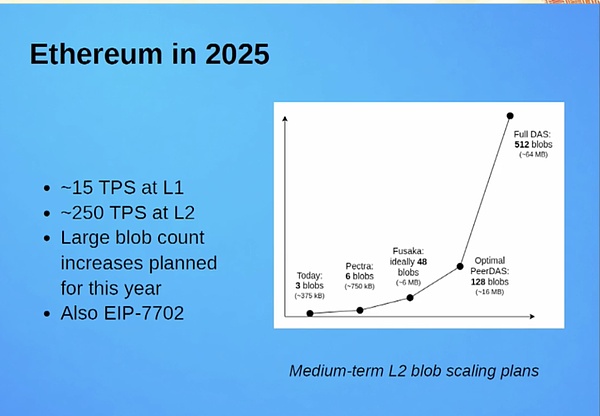
This transformation is not accidental, but the result of Ethereum strictly constructing according to the diagram and continuously iterating the roadmap. We can briefly review the key upgrades of the Ethereum network in recent years:
-
In 2022, Ethereum successfully moved to the PoS mechanism through The Merge upgrade.Greatly reduce energy consumption and free up execution layer bandwidth for subsequent upgrades;
-
In 2024, the Dencun upgrade was successfully activated and the Blob data mechanism was introduced.Provides low-cost, temporary storage space for L2, which reduces Rollup costs and opens channels for scalability;
-
Not long agoThe Pectra upgrade was successfully launched on May 7, greatly optimizing the verification operation process.and enhance flexibility in participating in PoS systems;
The next step of Fusaka upgrade is a key step in continuing the above process.
According to the latest statement by Tomasz Kajetan Stańczak, co-executive director of the Ethereum Foundation, Fusaka will go online in the third or fourth quarter of 2025 (the time is to be finalized), and plans to implement multiple core EIPs including PeerDAS data availability sampling, further pushing Ethereum from a performance bottleneck to mainstream application.
It can be said, from The Merge → Dencun → Pectra → Fusaka, Ethereum is moving towards its long-term blueprint in an orderly manner,That is, to build a global network that combines security, scalability, decentralization and sustainability.
Fusaka Upgrade Panoramic View
Judging from the 12 core EIPs included in this upgrade, it basically covers multiple technical dimensions such as data availability, node lightweighting, EVM optimization, and execution layer and data layer collaboration mechanisms.
Among them, the most concerned proposal for this Fusaka upgrade is EIP‑7594 (PeerDAS), which introduces the “Data Availability Sampling (DAS)” mechanism, allowing validators in the network to complete verification by simply downloading a part of the Blob data without storing all data in full.
This greatly reduces the network burden, improves verification efficiency, and paves the way for L2’s large-scale transaction processing capabilities. The concept of “Blob” here can be traced back to EIP-4844 introduced in the Dencun upgrade in 2024.
As Ethereum’s most important milestone in 2024, Dencun’s upgraded EIP-4844 has enabled transactions carrying blobs for the first time, allowing L2s to choose not to use the traditional calldata storage mechanism, thus greatly improving the Gas fees required for transactions and transfers on L2.
So what is carrying a blob transaction?In short, it is to embed a large amount of transaction data into the blob, which can significantly reduce the storage and processing burden of the Ethereum main network, and does not include the Ethereum main network state, which directly solves the L1 cost problem related to data availability.Ensure that the L2 platform can provide cheaper and faster transactions without compromising Ethereum-based security and decentralization.
The blob expansion here is also based on Pectra. The Pectra upgrade in May has increased the blob capacity from 3 to 6. It is worth mentioning that Vitalik once publicly stated that ideally, Fusaka will expand the blob capacity to 72 blocks (first to 12~24 in stages). If DAS is fully implemented in the future, the theoretical maximum capacity can reach 512 Blobs/blocks.
Once implemented, L2’s processing capacity (TPS) is expected to jump to tens of thousands, which will greatly improve the availability and cost structure of high-frequency interaction scenarios such as DApps, DeFi, social networks, and games on the chain. This is also one of the core directions in the “L2 Security and Finalization Roadmap” proposed by Vitalik.
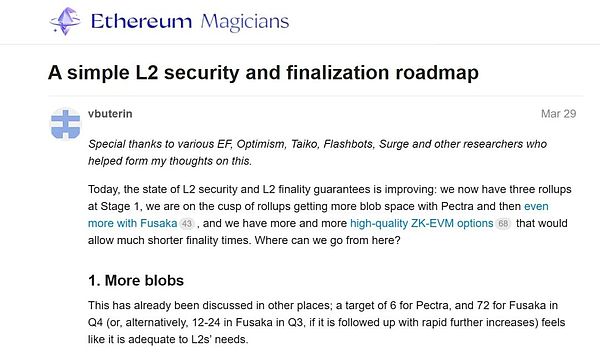
At the same time, Fusaka also plans to lighten the state and node structure by introducing Verkle tree, which not only significantly compresses the state proof volume, making light client and stateless verification possible, but also helps to promote the decentralization and popularization of Ethereum.
In addition, Fusaka also focuses on the flexibility and performance bottlenecks of the virtual machine layer (EVM), including the following proposals:
-
EVM and contract optimization rely on EIP‑7939 (CLZ opcode): efficiently implement bit operations and accelerate encryption operations;
-
EIP‑7951 (secp256r1 alternative support): Improves compatibility with Web2 and enterprise architectures;
-
EIP‑7907: Expand the contract size limit, support deployment of more complex logic, and improve developer flexibility;
In order to ensure that expansion does not affect network stability, Fusaka has also introduced EIP‑7934 to set block volume limits to ensure that blocks will not be too heavy due to blob expansion, and adjusts blob usage costs through EIP-7892 / EIP-7918 to prevent misuse of resources and dynamically match supply and demand fluctuations.
What is the watershed between Ethereum expansion and experience?
If we look at it overall, we will find that Fusaka is not only a technological upgrade, but also hopes to lay a bridge from “scalability to availability” at multiple key levels.
For example, for Rollup developers, it means lower data writing costs and more flexible interaction space; for wallet and infrastructure providers, it means supporting more complex interactions and heavier load node environments; for end users, it is a lower-cost and faster-responsive on-chain operation; for enterprises and compliant users, EVM expansion and proof of state simplification will also make on-chain interactions easier to access regulatory systems and deploy at scale.
But you should still be cautious and optimistic.As of the time of publication, Fusaka was still testing on multiple Devnets, and the final launch time still may change.Under the optimistic situation, Fusaka is expected to complete the mainnet deployment by the end of 2025, which may become another important milestone in Ethereum’s history after The Merge.
Overall, Fusaka is not only limited to the enhancement of on-chain expansion capabilities, but also represents a key step in the transition from Ethereum to mainstream commercial applications and ordinary users. It is expected to provide a technical foundation for the next stage of Rollup ecosystem, enterprise-level Dapps, and on-chain user experience.
The real watershed of Ethereum’s move towards large-scale mainstream applications may be approaching.

